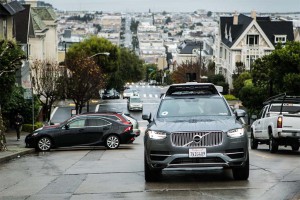(Update: Uber has since resumed its autonomous pilot program and police have issued a ticket to the human driver who they believe caused the Arizona crash.)
Ride-sharing giant Uber has suspended its autonomous vehicle pilot program in the wake of a crash involving one of its modified Volvo XC90 SUVs.
It comes as the latest setback for Uber, which has begun a search for a new management team to help address a series of embarrassments including numerous claims of sexual harassment, as well as a video showing its founder and CEO Travis Kalanick berating one of the company’s drivers over pay concerns.
“We are continuing to look into this incident,” an Uber spokesperson said of the Saturday multi-vehicle crash in Tempe, Arizona that resulted in the Uber SUV rolling onto its side. “There were no serious injuries,” according to Uber, though two Uber “safety” operators were in the front seats.
The incident occurred when a second vehicle “failed to yield” to the Uber Volvo while making a turn, a spokesperson for the Tempe Police Department told the Reuters news service. Images and videos from the scene show the XC90 rolled on its side, with two other vehicles showing damage from the crash.
Uber has been a strong advocate for autonomous vehicles, Kalanick frequently promoting the long-term benefits of fully driverless technology. He contends that it will allow Uber to lower the price of a ride to the point where it will be cheaper to use the service rather than owning a private vehicle.
The company last year launched its first pilot program in Pittsburgh, while also establishing an autonomous vehicle research center in that city. Last December, Uber started another pilot in its home town of San Francisco, but it ran into legal trouble for refusing to obtain a state permit for its vehicles, as 26 other companies have so far done. It pulled the modified Volvo’s out of the city a week later, moving them to Arizona.
Last month, Uber received a permit from the California Department of Motor Vehicles, and it is relaunching the San Francisco project. But it also has continued testing in the Phoenix area, the March 25 crash occurring in the suburb of Tempe.
It is not clear when Uber will resume testing in the wake of that incident, but the company has had other problems with its autonomous program. Internal reports leaked out earlier this month indicating that, on average, Uber’s self-driving prototypes required the trained operators seated behind the steering wheel to take control of the vehicles, on average, every 0.8 miles.
(For more on that report, Click Here.)
That was a far more frequent occurrence than what has been reported by Waymo, the Google spin-off that is also operating an expansive network of autonomous vehicle testing programs across the country.
Waymo has had nearly 20 minor crashes since it began its testing seven years ago, though only one has been blamed on its vehicles. Company officials there have acknowledged one of the biggest challenges is trying to tach autonomous vehicles how to anticipate what humans do behind the wheel do and how to respond when the other driver makes a mistake.
The most serious reported incident involving a vehicle using some form of autonomous technology occurred last May, when a Tesla Model S operating in Autopilot mode crashed in Florida, killing a former Navy SEAL. Federal investigators blamed Joshua Brown for failing to remain on the alert in the case of an emergency, but Tesla has since taken steps to improve the capabilities of the Autopilot system.
With no injuries reported, the crash of the Uber vehicle might have gone with relatively little notice, but Uber has been in the headlines for a variety of problems in recent months. That includes not only the flap over the autonomous pilot program in San Francisco, but a series of sexual harassment incidents.
That was triggered by a blog post by a former Uber engineer who outlined the issues she faced, including the aggressive come-on of her one-time boss and the failure of Uber’s HR department to act upon her complaints. Even as the ride-sharing service announced a probe headed by former U.S. Attorney-General Eric Holder, more concerns emerged. A senior engineering exec hired from Google was forced out when his own issues with sexual harassment surfaced.
(Uber hires former U.S. Attorney General to investigate harassment claims. Click Here for the story.)
Over this past weekend, meanwhile, a report was published by tech website The Information indicating that Emil Michael, a senior Uber executive, was trying to cover up evidence of a visit to a karaoke bar during trip to Seoul, Korea in 2014 in which female employees were pinned with numbers and then selected by male guests.
CEO Kalanick, who has acknowledged problems with Uber’s macho corporate culture, ran into his own headaches last month when a video surfaced showing him berating a company driver who had complained about declining payments.
Kalanick subsequently said he needed management help and announced a search for a new COO. But that move itself had unintended consequences when, last week, Uber’s president, Jeff Jones, resigned after just six months, apparently after realizing he was not the first pick to succeed Kalanick.
(Another day, another problem, as Uber’s new president resigns. Click Here for the latest.)
Uber, the country’s largest ride-sharing service has also had its financial problems of late, most recently reporting an $800 million loss for the third quarter of 2016. Separately, it has been struggling with boycotts by once-loyal customers who have been angered not only by the sexual harassment scandal but CEO Kalanick’s initial involvement in an economic advisory panel set up by Pres. Donald Trump. Kalanick has since resigned from that board.
The setbacks faced by Uber have been viewed by many industry analysts as opening up opportunities for its key rival. Lyft has, in recent months, raised new capital and has been drawing numerous drivers away from Uber – in part by allowing customers to tip. The smaller ride-sharing service also plans a new program that will encourage riders to “round up” their payments to donate to numerous charities.




Humans – 1
Skynet – 0